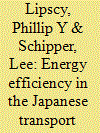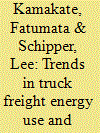|
|
|
Sort Order |
|
|
|
Items / Page
|
|
|
|
|
|
|
| Srl | Item |
| 1 |
ID:
118816


|
|
|
|
|
| Publication |
2013.
|
| Summary/Abstract |
This paper identifies trends in new gasoline and diesel passenger car characteristics in the European Union between 1995 and 2009. By 2009 diesels had captured over 55% of the new vehicle market. While the diesel version of a given car model may have as much as 35% lower fuel use/km and 25% lower CO2 emissions than its gasoline equivalent, diesel buyers have chosen increasingly large and more powerful cars than the gasoline market. As a result, new diesels bought in 2009 had only 2% lower average CO2 emissions than new gasoline cars, a smaller advantage than in 1995. A Laspeyres decomposition investigates which factors were important contributors to the observed emission reductions and which factors offset savings in other areas. More than 95% of the reduction in CO2 emissions per km from new vehicles arose because both diesel and gasoline new vehicle emissions/km fell, and only 5% arose because of the shift from gasoline to diesel technology. Increases in vehicle mass and power for both gasoline and diesel absorbed much of the technological efficiency improvements offered by both technologies. We also observe changes in the gasoline and diesel fleets in eight EU countries and find changes in fuel and emissions intensities consistent with the changes in new vehicles reported. While diesel cars continue to be driven far farther than gasoline cars, we attribute only some of this difference to a "rebound effect". We conclude that while diesel technology has permitted significant fuel savings, the switch from gasoline to diesel in the new vehicle market contributed little itself to the observed reductions in CO2 emissions from new vehicles.
|
|
|
|
|
|
|
|
|
|
|
|
|
|
|
|
| 2 |
ID:
121282


|
|
|
|
|
| Publication |
2013.
|
| Summary/Abstract |
We examine energy efficiency in the Japanese transportation sector since the 1970s. Comparisons with the United States and other developed economies illustrate that Japan primarily stands out due to low activity levels and modal structure rather than modal energy intensity. On-road automobile energy intensity has shown little improvement, albeit from a low base, over the past four decades. We also consider policy measures undertaken by the Japanese government. Political arrangements in Japan after World War II made it attractive for politicians to pursue energy conservation by making transportation, particularly by automobile, expensive for the average Japanese citizen. The revenues raised from various fees and taxes on automobile transportation were redistributed to core supporters of the ruling Liberal Democratic Party. These political arrangements have come under fire in recent years, calling into question Japan's traditional approach towards transportation sector energy efficiency.
|
|
|
|
|
|
|
|
|
|
|
|
|
|
|
|
| 3 |
ID:
121274


|
|
|
|
|
| Publication |
2013.
|
| Summary/Abstract |
One of the most notable outcomes of Ireland's recent spectacular rise in income was an apparent 140% increase in domestic passenger transport fuel use from 1990 to 2008, at the same time as the car stock has more than doubled in magnitude. However, there have been very few comparisons and decomposition analyses of the data underlying this increase in travel. This paper addresses this gap by (i) refining passenger transport data estimates, in particular improving existing estimates of passenger-kilometre data, (ii) comparing trends in Irish private car ownership, usage, and activity to international historical trajectories, and (iii) performing a decomposition analysis of Irish passenger transport using the Refined Laspeyres Method. The international comparison indicates that Ireland's per capita private car usage and car activity have followed intermediate trajectories relative to the historical paths of Sweden and the UK. These trajectories of car usage and activity have contributed to the growth in fuel use, and the Refined Laspeyres decomposition formally decomposes the factors accounting for this growth. Activity was the main driver of the increase in fuel use, although intensity also contributed significantly. Despite decreasing load factors and average annual distances in cars, activity has continued to rise each year.
|
|
|
|
|
|
|
|
|
|
|
|
|
|
|
|
| 4 |
ID:
109687


|
|
|
|
|
| Publication |
2011.
|
| Summary/Abstract |
This paper provides for the first time a complete analysis of recent trends in activity, carbon emissions, modal shares, energy intensities, vehicle use and fuels in the Spanish transport system from 1990 to 2008 and discusses policy options. Passenger and freight activities have increased in Spain and are projected to continue, presenting a challenge for sustainable mobility efforts; emissions have increased, mainly fueled by the rise in activity; modal shares have pulled away from public transport, with a decrease in bus and rail, towards an increase in car and air travel; energy intensities, though initially decreasing, are currently increasing; and fuel use has taken over 37% of Spanish final energy consumption.
To target these issues the Spanish government has focused its efforts in targeting energy efficiency through dieselization, which has not led to positive results. More recently policies and measures have been directed towards redirecting modal shares and diversifying the fuel mix. Little has been done to reduce activity besides some anecdotic public awareness campaigns. Activity reduction may be achieved with regulations, restrictions and mobility plans; by increasing high speed rail and rail freight transport; by improving intermodality and tying the Spanish rail network with the EU; and with more urban transport planning at local level.
|
|
|
|
|
|
|
|
|
|
|
|
|
|
|
|
| 5 |
ID:
096726


|
|
|
|
|
| Publication |
2010.
|
| Summary/Abstract |
Having a clear understanding of transport energy use trends is crucial to identifying opportunities and challenges for efficient energy use for the transport sector. To this date, however, no detailed analysis has been conducted with regard to rapidly growing passenger transport energy use in South Korea. Using bottom-up data developed from a variety of recent sources, we described the trends of transport activity, energy use, and CO2 emissions from South Korea's transport sector since 1986 with a particular focus on its passenger transport. By decomposing the trends in passenger transport energy use into activity, modal structure, and energy intensity, we showed that while travel activity has been the major driver of the increase in passenger transport energy use in South Korea, the increase was to some extent offset by the recent favorable structural shift toward bus travel and away from car travel. We also demonstrated that while bus travel has become less energy intensive since the Asian Financial Crisis, car travel has become increasingly energy intensive.
|
|
|
|
|
|
|
|
|
|
|
|
|
|
|
|
| 6 |
ID:
097526


|
|
|
|
|
| Publication |
2010.
|
| Summary/Abstract |
Having a clear understanding of transport energy use trends is crucial to identifying opportunities and challenges for efficient energy use for the transport sector. To this date, however, no detailed analysis has been conducted with regard to rapidly growing passenger transport energy use in South Korea. Using bottom-up data developed from a variety of recent sources, we described the trends of transport activity, energy use, and CO2 emissions from South Korea's transport sector since 1986 with a particular focus on its passenger transport. By decomposing the trends in passenger transport energy use into activity, modal structure, and energy intensity, we showed that while travel activity has been the major driver of the increase in passenger transport energy use in South Korea, the increase was to some extent offset by the recent favorable structural shift toward bus travel and away from car travel. We also demonstrated that while bus travel has become less energy intensive since the Asian Financial Crisis, car travel has become increasingly energy intensive.
|
|
|
|
|
|
|
|
|
|
|
|
|
|
|
|
| 7 |
ID:
091514


|
|
|
|
|
| Publication |
2009.
|
| Summary/Abstract |
In the age of global supply chains and "just in time" logistics, fast and efficient goods movement is often seen as an economic imperative. Growth in global goods movement not only translates into growth in commercial trucking activity but also into growth in the share of trucking compared to other modes of in-country freight transportation. These trends have a significant impact on the energy intensity of freight transport. Using a bottom-up approach relying on national data, this study compares the energy intensity of truck freight in Australia, France, Japan, the United Kingdom and the United States from 1973 to the present.
|
|
|
|
|
|
|
|
|
|
|
|
|
|
|
|
| 8 |
ID:
113444


|
|
|
|
|
| Publication |
2012.
|
| Summary/Abstract |
Based on detailed national and international data on freight transportation, we analyze trends in freight CO2 emissions in 11 IEA countries from the earliest year of data availability to 2007-2010. The cross-country comparison of the freight transportation sector indicates that per capita CO2 emissions span a wide range and are mostly determined by local needs without full knowledge or coordination with policies and practices in other countries. Over the last several decades, while many developed countries have experienced decreased coupling between total freight activity (measured in tonne-km) and income, no major indication of decreased coupling between trucking and income was found. Rather, the coupling has been strengthened in many countries due to a continued increase in the share of trucking in total freight activity. The energy intensity of trucking has exhibited very large variation among the countries, and its recent international trends are mixed, providing greater challenges to reduce freight CO2 emissions. Modal shift toward rail away from truck presents a sizeable opportunity to reduce freight CO2 emissions, although the potential gain varies widely among the countries.
|
|
|
|
|
|
|
|
|
|
|
|
|
|
|
|
|
|
|
|
|